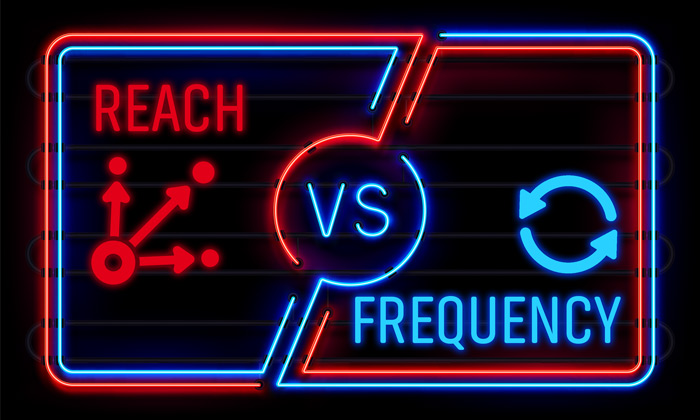One question that is asked by marketers regularly to GrowMail’s marketing coaches is whether they should reach more homes or increase the frequency with a smaller audience.
Say, for example, you only have the budget to target 30,000 households at one time or 10,000 people three times. Which strategy will generate more leads or transactions from your direct mail campaign?
What do reach and frequency mean?
They’re quite simple. “Reach” is the size of your list or audience; it’s the number of people you literally ‘reach’ with your message.
Meanwhile, “frequency” refers to how often you mail them. So when you say, “I mailed this postcard to my list every two months for the past year,” you’re talking about frequency.
Ideally, your mailings would be high in reach and frequency. If you have a budget large enough to hit your entire targeted audience, and you’re regularly reminding them of your offerings, you’ll get responses from qualified leads, which can then turn into paying customers. It’s practically guaranteed.
However, our situations are rarely ideal. The hard truth is that most marketing budgets are limited in the amount of material they can mail out, which necessitates a more strategic approach to direct mail.
The classic strategic dilemma that small business marketers often contend with is so old as to be timeless: Given that you have to pick one, which do you choose: more reach, or more frequency
Simply put, should you:
– Send one mailing to a list of 30,000 people, or
– Send three mailings to list of 10,000 people?
Most people choose option (1): more reach. After all, how are you going to grow without new customers? Sales is so often a numbers game, so the more comprehensive your pool of prospects, the more sales you’ll make… right?
Actually, no. Not by a long shot.
If you only pick one, bet on frequency.
At Grow Mail, we’ve sent millions of postcards on behalf of businesses throughout the country. And our data shows us that, somewhat counterintuitively, frequency is more important than reach.
So if we were to take the example above, it’d be more beneficial to send three mailings to the smaller list of 10,000 people.
Why is that?
Well, for starters, not everybody is going to see or even receive your first mailing. Maybe it got buried under all the other direct mailings your prospects get every day. Maybe whoever handles their mail throws it away before they can even get a look. Some of these people may turn out to be very interested in your product – but if you didn’t connect with them on that one mailing, you’ve lost them.
And even if they do see your postcard, and are interested, they soon get caught up in their busy lives and forget to follow up, sign up, purchase, or do whatever you asked them to do. And so, they need reminders.
Finally, consider the fact that prospects receiving your first mailing may need to see it multiple times before showing interest. According to a recent study by Google, people receive an average of 10 marketing messages before making a purchase decision.
And if you’ve been mailing them regularly, your brand will be on the top of their minds when they do decide to buy.
The sole exception to this rule is for businesses with high purchasing frequencies – like restaurants, for example. They do benefit from frequency, but can powerfully leverage reach, based on proximity to the establishment.
Regardless of how you balance your reach and frequency, make sure you remember one thing:
Track, track, track your mailings!
Always track your postcard’s performance – both in terms of geography and in messaging/creative. In the age of the Internet, this has become very easy to do (with customized URLs and landing pages, for instance).
And it’s critical to growing your business.
By tracking performance, you can determine your cost of customer acquisition. If the cost is high, retire or modify your campaign. If the cost is low, keep it.
Then, once you go through a few iterations, you’ll find it much easier to profitably scale your business — provided you’re available and able actually to deliver your product or service, that is!
